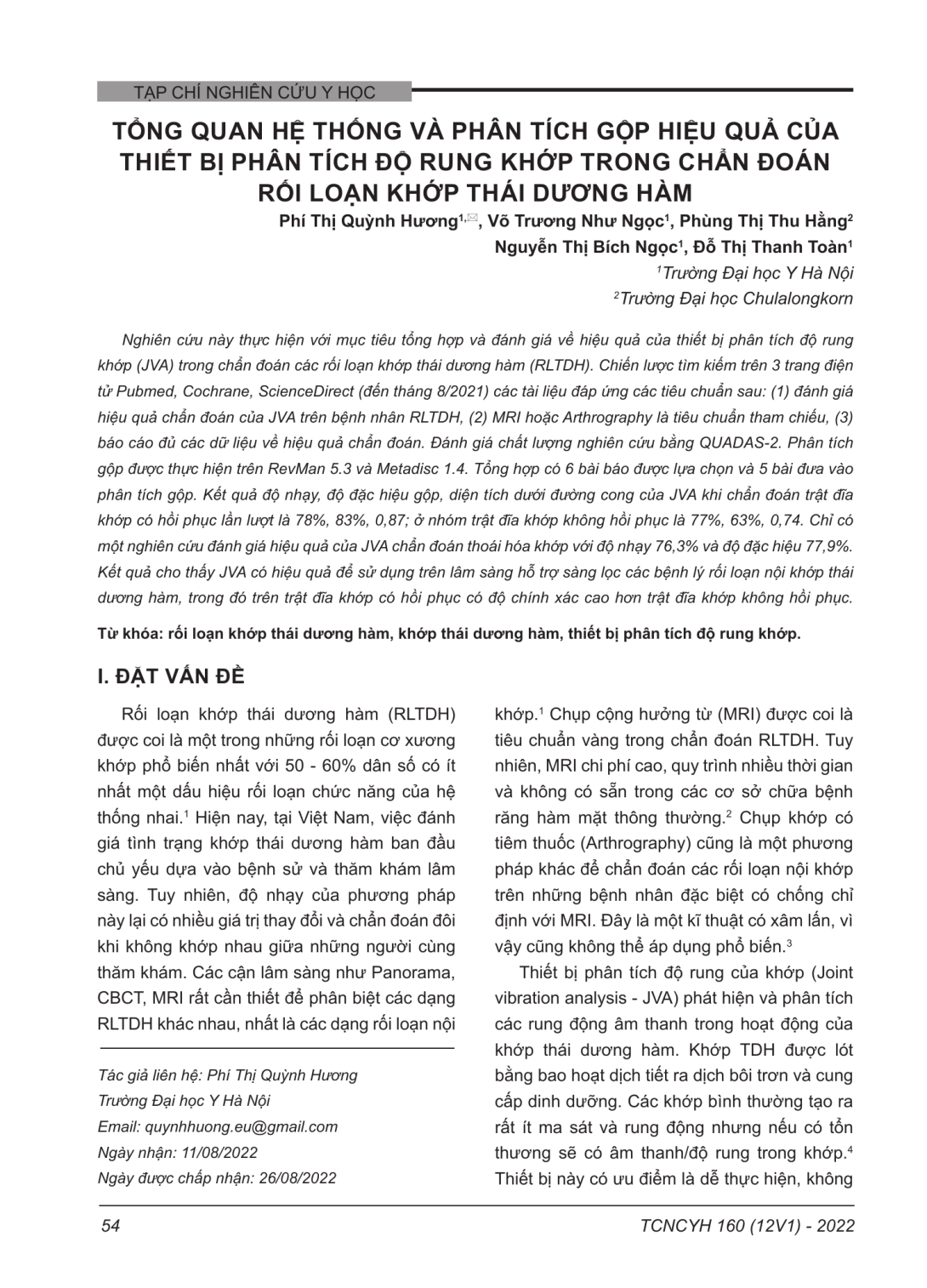
Nghiên cứu tổng hợp và đánh giá về hiệu quả của thiết bị phân tích độ rung khớp (JVA) trong chẩn đoán các rối loạn khớp thái dương hàm (RLTDH). Chiến lược tìm kiếm trên 3 trang điện tử Pubmed, Cochrane, ScienceDirect (đến tháng 8/2021) các tài liệu đáp ứng các tiêu chuẩn sau: (1) đánh giá hiệu quả chẩn đoán của JVA trên bệnh nhân RLTDH, (2) MRI hoặc Arthrography là tiêu chuẩn tham chiếu, (3) báo cáo đủ các dữ liệu về hiệu quả chẩn đoán. Đánh giá chất lượng nghiên cứu bằng QUADAS-2. Phân tích gộp được thực hiện trên RevMan 5.3 và Metadisc 1.4. Tổng hợp có 6 bài báo được lựa chọn và 5 bài đưa vào phân tích gộp. Kết quả độ nhạy, độ đặc hiệu gộp, diện tích dưới đường cong của JVA khi chẩn đoán trật đĩa khớp có hồi phục lần lượt là 78%, 83%, 0,87; ở nhóm trật đĩa khớp không hồi phục là 77%, 63%, 0,74. Chỉ có một nghiên cứu đánh giá hiệu quả của JVA chẩn đoán thoái hóa khớp với độ nhạy 76,3% và độ đặc hiệu 77,9%. Kết quả cho thấy JVA có hiệu quả để sử dụng trên lâm sàng hỗ trợ sàng lọc các bệnh lý rối loạn nội khớp thái dương hàm, trong đó trên trật đĩa khớp có hồi phục có độ chính xác cao hơn trật đĩa khớp không hồi phục.
This systematic review and meta-analysis aimed to investigate the diagnostic capability of Joint Vibration Analysis (JVA) to assess temporomandibular joint disorders (TMD). A systematic unrestricted search was done in the Pubmed, Cochrane and ScienceDirect databases until August, 2021. The eligibility criteria included studies that: (1) evaluated the efficacy of JVA in assessing patients with TMD, (2) used MRI or Arthrography as the reference standard, (3) provided sufficient accuracy outcome variables. The risk of bias was evaluated using the QUADAS-2. Meta-analyses were performed with RevMan 5.3 and Metadisc 1.4. A total of 6 studies were evaluated and only 5 qualified for meta-analyses. For the diagnosis of disc displacement with reduction (DDR), the pool sensitivity, pool specificity and summary receiver operating characteristic curve (sROC) of JVA were respectively 78%, 83%, 0.87; while those results of disc displacement without reduction (DDWR) were respectively 77%, 63%, 0.74. Only one study evaluated the efficacy of JVA in diagnosing degenerative joint disease (DJD) with a sensitivity of 76.3% and a specificity of 77.9%. We found that the diagnostic value of JVA for screening disc displacement is sufficient for its use in the decision-making in dental practice, in which subjects with suspected DDR have higher accuracy outcome than DDWR.
- Đăng nhập để gửi ý kiến
